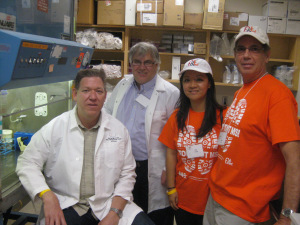The Interface Between Immunology and Neurobiology: Evaluating the Promise of Stem Cells for Treating Multiple Sclerosis
Posted on April 21, 2015
April is National Awareness month for Multiple Sclerosis (MS). To raise awareness, the Walsh Lab from the Sue & Bill Gross Stem Cell Research Center at UC, Irvine participated in the walk and hosted a lab tour on Saturday, April 11th. Our current fellow, Warren Plaisted, explains what current research is being done regarding MS. The National Multiple Sclerosis Society, Pacific Coast Chapter works closely with Dr. Craig Walsh, who is our principal investigator researching MS.
Multiple sclerosis (MS) is an autoimmune disorder in which a patient’s own white blood cells, particularly T cells, cross the barrier that normally protects the brain and spinal cord and mistakenly attack myelin, the coating that insulates nerve fibers. Loss of myelin disrupts conduction of nerve impulses from the central nervous system (CNS) to the rest of the body, resulting in a variety of symptoms, including muscle weakness and fatigue, vision loss, loss of balance, and emotional and cognitive decline. In contrast to many other neurodegenerative diseases, the majority of patients with MS develop symptoms between the ages of 16 and 45, making it the leading cause of disability in young women and the second leading cause of disability in young men. Today, there are at least 8 FDA-approved immune modulatory therapies for treating MS, but those drugs are only partially effective and do not address the issue of long-term damage to the brain and spinal cord.

Lab tour at the Sue & Bill Gross Stem Cell Research Center at UCI.

UC Irvine is one of only 15 institutions in the U.S. to house a Collaborative Center for MS Research (as designated by the National Multiple Sclerosis Society). Established in 2011, the over-arching goal of the Multiple Sclerosis Research Center (MSRC) at UCI is to pool talent and resources from laboratories across campus for the development of novel treatment strategies against MS. One such laboratory is that of Dr. Craig M. Walsh, co-director of the MSRC. Located in the Sue & Bill Gross Stem Cell Research Center, Dr. Walsh’s team is using mouse models of MS to investigate how transplanted stem cells can control immune cell infiltration into the CNS and promote myelin regeneration. They are particularly interested in neural precursor cells (NPCs), a type of stem cell that can give rise to the main cell types in the brain and spinal cord. Using a virus-induced mouse model of MS, his group recently demonstrated that NPCs derived from human embryonic stem cells suppress inflammation in the CNS through crosstalk with a subset of suppressor T cells called regulatory T cells (Tregs). Moreover, promotion of Treg activity by human NPCs led to remyelination and improvements in motor skills in transplanted mice. Importantly, sustained benefits in ambulation were not dependent on survival of the stem cell graft. CIRM is currently funding Dr. Walsh’s research through the Translational Research grant (TR3-05603).
One current focus of the Walsh lab is the investigation of the therapeutic potential of NPCs generated from human induced pluripotent stem cells (iPSCs), a type of pluripotent cell that can be made from a patient tissue sample, propagated in a dish, and transformed into a neural precursor cell. Since iPSCs maintain the genetic background of the donor, using human iPSC-derived cells for transplantation may circumvent the need for immunosuppressant drugs that leave patients vulnerable to peripheral infection and re-activation of dormant viruses. Similar to their previous work, Walsh’s group has observed that NPCs generated from iPSCs can promote immune tolerance mechanisms through induction of Tregs, resulting in myelin sparing and regeneration. However, in the case of iPSC-derived cells, dampened immune cell accumulation and increased remyelination were not robust enough to improve the motor skills of transplanted mice. This suggests that not all NPCs are created equal, and the identification of the most therapeutically beneficial stem cells will be important before new treatment strategies move into the clinic.
 Warren C. Plaisted is a Ph.D. candidate and NIH-sponsored pre-doctoral fellow in the laboratory of Craig M. Walsh, Ph.D. at UCI. He’s funded under the NINDS T32 training grant NS082174. His current research is focused on mechanisms of rejection and repair following transplantation of neural stem cells into a virus-induced mouse model of Multiple Sclerosis. He has additional experience using human pluripotent stem cells to establish in vitro and in vivo disease models in areas where current models do not exist or do not adequately recapitulate patient symptoms.
Warren C. Plaisted is a Ph.D. candidate and NIH-sponsored pre-doctoral fellow in the laboratory of Craig M. Walsh, Ph.D. at UCI. He’s funded under the NINDS T32 training grant NS082174. His current research is focused on mechanisms of rejection and repair following transplantation of neural stem cells into a virus-induced mouse model of Multiple Sclerosis. He has additional experience using human pluripotent stem cells to establish in vitro and in vivo disease models in areas where current models do not exist or do not adequately recapitulate patient symptoms.